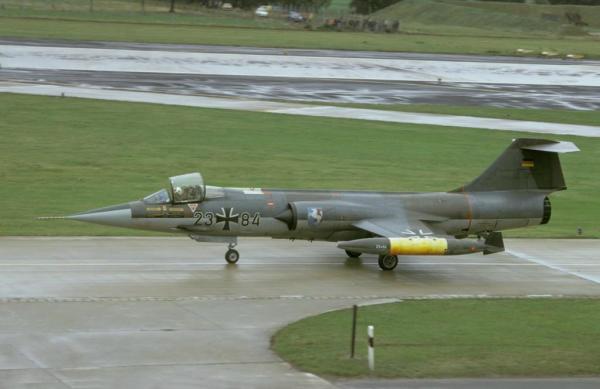
| Foto: JaboG36 |
For ten years the most beautiful and elegant fighter ever built was to grace the skies above the NATO-Airbase Hopsten/Dreierwalde. “Manned missile” was the name airmen gave to the F-104G “Starfighter”, that was capable of Mach 2 (twice the speed of sound) and cost about 6 million DM. Although tarnished by a series of crashes and dubbed by the media as “Widow Maker”, the Starfighter was considered to be a safe aircraft by the Hopsten pilots. Compared to the previous aircraft, the F-84F “Thunderstreak” JaboG 36 lost nine aircraft and six pilots in the 10 years of operation of the F-104G “Starfighter”, thus a lower accident rate.
On October 25, 1966, the Inspector General of the Luftwaffe, Lieutenant
General Johannes Steinhoff, formally baptised the housing and administration
buildings at the Schorlemerstrasse in Rheine with the name General-Wever-Kaserne.
The Luftwaffe chose the name of the first Chief of Staff of the Luftwaffe
who was killed in a plane crash in 1936 for his organizational abilities
and his strategic farsightedness during the rebuilding of the Luftwaffe.
To fulfil the new NATO-doctrine of “Flexible Response” of 1967, which
included the use of tactical nuclear weapons, a detachment of more than
100 American airmen was based at Hopsten AB. For several years they
lived with their families in the village of Dreierwalde. During war
conditions, after release from the American President, the specialists
would prepared the tactical nuclear weapons for JaboG 36 to deliver
them on strike missions. This arrangement was standard with several
allied air forces in Europe.
A separate ORA - facility (Quick Reaction Alert) was set-up on the air
base especially for this task that was sealed by a double fence and
the entrance was subject to strict security checks. Within this area
were hangars with doors opening in the front back, housing the aircraft
ready for take-off. Also, a building was provided with living and sleeping
quarters for German and American security personnel, maintenance crews
and the pilots for the QRA aircraft. The US-controlled nuclear weapons
were stored at the ammunition storage at Uthuisen. The weapons were
designated “Special Weapons” and were replaced every three months. They
were airlifted from a US depot within Germany to the German F-104G bases
by Douglas C-124” Globemaster”. The transport of the “Special Weapons”
from the storage at Uthuisen to the readied aircraft was practiced in
a monthly drill exercise with training rounds (inert bombs).
Employing up to 150 security personnel of the unit's own “Sicherungsstaffel-S”
(Security Squadron), each time the 3 km transfer between the ammunition
storage at Uthuisen and the air base took place, the path was cordoned
off hermetically. The column started to move with the “Special Weapon”
being either simulated by the exercise round Mk106 or the training bombs
BDU-8 or BDU-12, using a 4x4 Unimog towing the trailer. Sometimes a
routine exercise took place involving local emergency response forces
simulating a nuclear accident with the “Special Weapon”. After the transport
of the “Special Weapon” from the ammunition depot at Uthuisen to the
QRA area, four German airmen, the loading team for the nuclear device,
would load the weapon onto the central fuselage Station of the QRA F-104G
“Starfighter”. The time required for the loading of the nuclear weapon
was 30 minutes. The final activation of the “Special Weapon” was the
task of the US airmen. Specialists of the 50th Bomb Detachment loaded
the warhead and held the exclusive initialising codes.
An F-104G “Starfighter” loaded with a “Special Weapon” and four external
drop tanks had a low - level range of 1.300 km. The tactical targets
like troop concentrations of the second wave in the area of the former
Warsaw Pact would have been briefed to the crews shortly before take-off.
The task of the 2nd squadron of the wing remained unchanged. Its task was to maintain combat readiness with conventional weapons and to “Europeanise” the newly trained German F-104G pilots returning from training in the USA. In early 1972, changes within NATO led to the abandonment of the strike role. 1st Squadron assumed the fighter-bomber role by only conventional means. The US personnel for the “Special Weapons” departed Dreierwalde during that same year.
Foto: Lieuwe Hofstra |
Foto: JaboG36 |
Foto: JaboG36 |
The 27+27 in 1971 at Nörvenich
AB. © Spotter2000 |